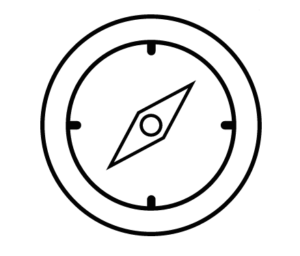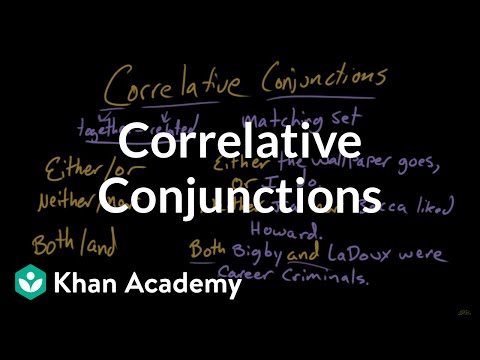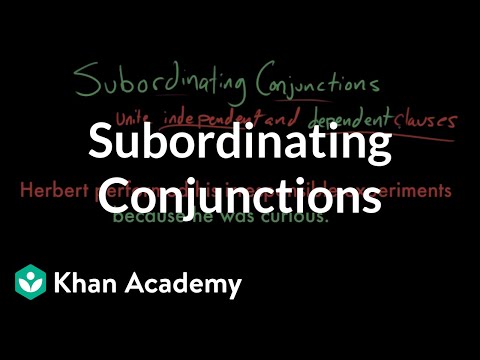16.14: Conjunctions
( \newcommand{\kernel}{\mathrm{null}\,}\)
- Correctly identify and use conjunctions in a sentence
Conjunctions are the words that join together sentences, phrases, and other words. Conjunctions are divided into several categories, each of which follows different rules. We will discuss coordinating conjunctions, adverbial conjunctions, correlative conjunctions, and subordinating conjunctions.
This SchoolHouse rock video on conjunctions has withstood the test of time—made in 1973, it remains relevant and entertaining today. Watch it for an overview of what conjunctions are and what they do.
You can view the transcript for “Schoolhouse Rock: Grammar- Conjunction Junction Music Video” here (opens in new window).
Coordinating Conjunctions
 The most common conjunctions are and, or, and but. These are all coordinating conjunctions. Coordinating conjunctions are conjunctions that join, or coordinate, two or more equivalent items (such as words, phrases, or sentences). The mnemonic acronym FANBOYS can be used to remember the most common coordinating conjunctions: for, and, nor, but, or, yet, and so. Here are some examples of them used in sentences:
The most common conjunctions are and, or, and but. These are all coordinating conjunctions. Coordinating conjunctions are conjunctions that join, or coordinate, two or more equivalent items (such as words, phrases, or sentences). The mnemonic acronym FANBOYS can be used to remember the most common coordinating conjunctions: for, and, nor, but, or, yet, and so. Here are some examples of them used in sentences:
- Nuclear-powered artificial hearts proved to be complicated, bulky, and expensive.
- Any external injury or internal injury puts patients at risk of uncontrolled bleeding.
- The current from the storage batteries can power lights, but the current for appliances must be modified within an inverter.
Are the correct coordinating conjunctions being used in each of the following sentences? Explain your reasoning:
- I love boxing or sewing. They’re both a lot of fun.
- Martin is pretty good at writing, for Jaden is better.
- Juana had to choose. Would she join the red team and the blue team?
[reveal-answer q=”843777″]Show Answer[/reveal-answer]
[hidden-answer a=”843777″]
- The conjunction or presents an alternative. However, the second sentence indicates that the speaker enjoys both activities. The correct sentence would use and: “I love boxing and sewing. They’re both a lot of fun.”
- The conjunction for presents a reason. It’s unlikely that Jaden being better is the reason Martin is pretty good at writing, so a different conjunction should be used. But would be a good fit here, since the ideas contrast: “Martin is pretty good at writing, but Jaden is better.”
- The conjunction and presents non-contrasting items or ideas. Since the first sentence sets up a choice, we know that Juana can’t be on both teams. The conjunction or presents an alternative and is the correct conjunction to use in this sentence: “Would she join the red team or the blue team?”
[/hidden-answer]
As you can see from the examples above, a comma only appears before these conjunctions sometimes. So how can you tell if you need a comma or not? There are three general rules to help you decide.
Rule 1: Joining Two Complete Ideas
Let’s look back at one of our example sentences:
The current from the storage batteries can power lights, but the current for appliances must be modified within an inverter.
There are two complete ideas in this sentence (a complete idea has both a subject and a verb). Because each of these ideas could stand alone as a sentence, the coordinating conjunction that joins them must be preceded by a comma. Otherwise you’ll have a run-on sentence.
Run-on sentences are one of the most common errors in college-level writing. Mastering the partnership between commas and coordinating conjunctions will go a long way toward resolving many run-on sentence issues in your writing. We’ll talk more about run-ons and strategies to avoid them in a later section.
Rule 2: Joining Two Similar Items
What if there is only one complete idea but two subjects or two verbs? Consider the following examples:
- Any external injury or internal injury puts patients at risk of uncontrolled bleeding.
- In the 1960s, artificial heart devices did not fit well and tended to obstruct the flow of venous blood into the right atrium.
The first sentence has two subjects: external injury and internal injury. They are joined with the conjunction or. The second sentence has two verbs: did not fit well and tended to obstruct. They are joined with the conjunction and. Neither sentence requires additional punctuation.
Rule 3: Joining Three or More Similar Items
What do you do if there are three or more items?
- Anna loves to run, David loves to hike, and Luz loves to dance.
- Fishing, hunting, and gathering were once the only ways for people do get food.
- Emanuel has a very careful schedule planned for tomorrow. He needs to work, study, exercise, eat, and clean.
As you can see in the examples above, there is a comma after each item, including the item just before the conjunction (and). There is a bit of contention about that final comma, but most styles prefer to keep include it (it’s called the serial comma). We discuss the serial comma in more depth later as well.
Many students are taught—and some style guides maintain—that English sentences should not begin with a coordinating conjunction. However, there is nothing grammatically incorrect about doing so. The practice is likely discouraged because it is thought to help students avoid creating sentence fragments, but there is nothing wrong with starting a sentence with a coordinating conjunction.
Adverbial Conjunctions
 Adverbial conjunctions, or conjunctive adverbs, link two separate thoughts or sentences. When used to interrupt thoughts, as in the first example, below, a comma is required on either side of the conjunction. When used to separate complete ideas (independent clauses, which each contain a subject and a verb), a semicolon is required before the conjunction and a comma after. This is the case in the second example, below:
Adverbial conjunctions, or conjunctive adverbs, link two separate thoughts or sentences. When used to interrupt thoughts, as in the first example, below, a comma is required on either side of the conjunction. When used to separate complete ideas (independent clauses, which each contain a subject and a verb), a semicolon is required before the conjunction and a comma after. This is the case in the second example, below:
- The first artificial hearts were made of smooth silicone rubber, which apparently caused excessive clotting and, therefore, uncontrolled bleeding.
- The Kedeco produces 1200 watts in 17 mph winds using a 16-foot rotor; on the other hand, the Dunlite produces 2000 watts in 25 mph winds.
Adverbial conjunctions include the following words; however, it is important to note that this is by no means a complete list.
| therefore | however | in other words |
| thus | then | otherwise |
| nevertheless | on the other hand | in fact |
Correlative Conjunctions
Correlative conjunctions are word pairs that work together to join words and groups of words of equal weight in a sentence.
The following video explains this type of conjunction and describes the five most common pairs.
You can view the transcript for “Correlative Conjunctions” here (opens in new window).
The table below shows some examples of correlative conjunctions used in sentences:
| Correlative Conjunction | Example |
|---|---|
| either . . . or | You either do your work or prepare for a trip to the office. (Either do, or prepare) |
| neither . . . nor | Neither the basketball team nor the football team is doing well. |
| not only . . . but (also) | He is not only handsome but also brilliant. (Not only A but also B) |
| Not only is he handsome, but also he is brilliant. (Not only is he A, but also he is B) | |
| both . . . and | Both the cross-country team and the swimming team are doing well. |
| whether . . . or | You must decide whether you stay or go. (It’s up to you) |
| Whether you stay or you go, the film will start at 8 pm. (It’s not up to you) | |
| just as . . . so | Just as lots of Americans love basketball, so many Canadians love ice hockey. |
| as much . . . as | Football is as much an addiction as it is a sport. |
| no sooner . . . than | No sooner did she learn to ski than the snow began to thaw. |
| rather . . . than | I would rather swim than surf. |
| the . . . the | The more you practice dribbling, the better you will be at it. |
| as . . . as | Football is as fast as hockey (is (fast)). |
Subordinating Conjunctions
 Subordinating conjunctions, are conjunctions that join an independent clause and a dependent clause. Here are some examples of subordinating conjunctions:
Subordinating conjunctions, are conjunctions that join an independent clause and a dependent clause. Here are some examples of subordinating conjunctions:
- The heart undergoes two cardiac cycle periods: diastole, when blood enters the ventricles, and systole, when the ventricles contract and blood is pumped out of the heart.
- Whenever an electron acquires enough energy to leave its orbit, the atom is positively charged.
- She did the favor so that he would owe her one.
Let’s take a moment to look back at the previous examples. Can you see the pattern in comma usage? The commas aren’t dependent on the presence of subordinating conjunctions—they’re dependent on the placement of clauses they’re in. Let’s revisit a couple of examples and see if we can figure out the exact rules:
- The heart undergoes two cardiac cycle periods: diastole, when blood enters the ventricles, and systole, when the ventricles contract and blood is pumped out of the heart.
- These clauses are both extra information: information that is good to know, but not necessary for the meaning of the sentence. This means they need commas on either side.
- Whenever an electron acquires enough energy to leave its orbit, the atom is positively charged.
- In this sentence, the dependent clause comes before an independent clause. This means it should be followed by a comma.
- She did the favor so that he would owe her one.
- In this sentence, the independent clause comes before a dependent clause. This means no comma is required.
The most common subordinating conjunctions in the English language are shown in the table below:
| after | although | as | as far as | as if | as long as | as soon as |
| as though | because | before | even if | even though | every time | if |
| in order that | since | so | so that | than | though | unless |
| until | when | whenever | where | whereas | wherever | while |
Watch this video from Khan Academy to learn more about when and how to use subordinating conjunctions.
You can view the transcript for “Subordinating Conjunctions” here (opens in new window).
https://lumenlearning.h5p.com/content/1290622574259907648/embed
[reveal-answer q=”769106″]Explain Answers[/reveal-answer]
[hidden-answer a=”769106″]Here are the sentences with suggested conjunctions. These are not the only possible solutions. If you answered something different, compare your reasoning with the explanation provided below.
- Karni’s roommate, Joana, decided to drive to work; therefore, Karni rode into the city with her.
- As the punctuation currently exists (a semicolon followed by a comma), the sentence needs an adverbial conjunction. However, using therefore here feels a little stuffy. If you change the semicolon to a comma and remove the second comma, you can then use the coordinating conjunction so instead, which feels more natural: “. . . , so Karni rode into the city with her.”
- They needed to turn left on 140th Street, but that street was under construction.
- Since the blank is preceded by a comma, a coordinating conjunction should go here. The conjunction but has the most appropriate meaning in this sentence.
- Before Karni could say anything, however, Joana had already found an alternate route.
- Since there is no comma after the first blank, we know we need a subordinating conjunction here. Before makes the most sense here.
- Since this blank appears in the middle of an idea, we know we need an adverbial conjunction here. However makes the most sense.
- No sooner did Karni arrive at work than her boss told her she would be working with her coworker Ian on her next project.
- The two blanks in this sentence indicate a correlative conjunction. The sentence indicates the two things happened at the same time, so no sooner . . . than is the correct option here.
- Karni was really impressed by Ian’s professional accomplishments, but she was anxious about working with him.
- Since the blank is preceded by a comma, a coordinating conjunction should go here. The conjunction but has the most appropriate meaning in this sentence.
- Karni thought Ian was annoying, unpredictable, and reckless.
- Since the blank is preceded by a comma, a coordinating conjunction should go here. The conjunction and has the most appropriate meaning in this sentence.
- However, Karni was willing to put aside her opinions to get the job done.
- Since the blank is followed by a comma, we know we need an adverbial conjunction here. However makes the sense here.
- She knew Ian would put in his best effort while they worked together, so she felt she could do no less—even if he frustrated her.
- Since there is no comma before or after the first blank, we know we need a subordinating conjunction here. While makes the most sense here, but as long as or if would also work.
- Since the blank is preceded by a comma, a coordinating conjunction should go here. The conjunction so has the most appropriate meaning in this sentence.
- This blank is a little trickier; it is preceded by a dash, which can stand in for a lot of different punctuation marks. A subordinating conjunction is likely the best solution. We’ve used even if here, but there are a lot of possibilities, including even though.
- Personal relationships are often as important as professional skills.
- The two blanks in this sentence indicate a correlative conjunction. The sentence indicates two things of equal importance, so as . . . as is the correct option here.
[/hidden-answer]
Contributors and Attributions
- Revision and Adaptation. Provided by: Lumen Learning. License: CC BY-SA: Attribution-ShareAlike
- Conjunction (grammar). Provided by: Wikipedia. Located at: en.Wikipedia.org/wiki/Conjunction_(grammar). License: CC BY-SA: Attribution-ShareAlike
- Basic Patterns and Elements of the Sentence. Authored by: David McMurrey. Located at: https://www.prismnet.com/~hcexres/textbook/twsent.html. License: CC BY: Attribution
- Correlative conjunctions. Authored by: David Rheinstrom. Provided by: Khan Academy. Located at: https://www.khanacademy.org/humanities/grammar/partsofspeech/conjunctions/v/correlative-conjunctions. License: CC BY-NC-SA: Attribution-NonCommercial-ShareAlike
- Image of compass. Authored by: Douglas Santos. Provided by: The Noun Project. Located at: https://thenounproject.com/search/?q=coordinate&i=223910. License: CC BY: Attribution
- Image of thought bubbles. Authored by: icon 54. Provided by: The Noun Project. Located at: https://thenounproject.com/search/?q=thoughts&i=393828. License: CC BY: Attribution
- Image of balanced scales. Authored by: Juan Pablo Bravo. Provided by: The Noun Project. Located at: https://thenounproject.com/term/balance/106372/. License: CC BY: Attribution
- Image of unbalanced scales. Authored by: Juan Pablo Bravo. Provided by: The Noun Project. Located at: https://thenounproject.com/term/balance/106371/. License: CC BY: Attribution
- Subordinate Conjunctions. Authored by: Khan Academy. Provided by: Khan Academy. Located at: https://www.khanacademy.org/humanities/grammar/parts-of-speech-the-preposition-and-the-conjunction/introduction-to-conjunctions/v/subordinating-conjunctions. License: Public Domain: No Known Copyright. License Terms: Standard YouTube License
- Schoolhouse Rock: Grammar - Conjunction Junction Music Video. Located at: https://www.youtube.com/watch?time_continue=2&v=RPoBE-E8VOc&feature=emb_logo. License: Other. License Terms: Standard YouTube License




